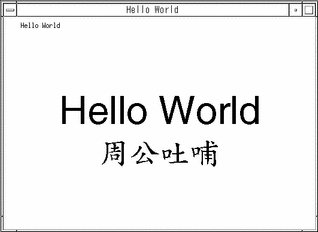Display PostScript System (DPS)
The Traditional Chinese Solaris operating environment provides PostScript fonts in the Display PostScript System (DPS). This section describes what you need to use DPS in Traditional Chinese Solaris software. For further details, see Programming the Display PostScript System with X, published by Adobe Systems.
Using Traditional Chinese PostScript Fonts and DPS Facilities
The Traditional Chinese Solaris operating environment DPS provides the fonts listed in the following table.
Table 6-1|
Font Name |
Description |
|---|---|
|
Kai-Medium |
Alias of Kai-Medium-EUC-H. |
|
Kai-Medium-EUC-H |
Kai-Medium font, EUC encoding, horizontal display; can be used like a Roman font. |
|
Kai-Medium-EUC-V |
Kai-Medium font, EUC encoding, vertical display; can be used like a Roman font. |
|
Kai-Medium-H |
Kai-Medium font, horizontal display, for making a composite with a Roman font. |
|
Kai-Medium-V |
Kai-Medium font, vertical display; for making a composite with a Roman font. |
|
Ming-Light |
Alias of Ming-Light-EUC-H. |
|
Ming-Light-EUC-H |
Ming-Light font, EUC encoding, horizontal display; can be used like a Roman font. |
|
Ming-Light-EUC-V |
Ming-Light font, EUC encoding, vertical display; can be used like a Roman font. |
|
Ming-Light-H |
Ming-Light font, horizontal display, for making a composite with a Roman font. |
|
Ming-Light-V |
Ming-Light font, vertical display; for making a composite with a Roman font. |
You can use the following Traditional Chinese fonts just as you would use Roman fonts:
-
Kai-Medium
-
Kai-Medium-EUC-H
-
Kai-Medium-EUC-V
-
Ming-Light
-
Ming-Light-EUC-H
-
Ming-Light-EUC-V
The following figure shows a sample of Kai-Medium and Ming-Light.

Creating Composite Roman and Traditional Chinese Fonts
You can create composite fonts using one Roman font and one of the following Traditional Chinese fonts:
-
Ming-Light-H
-
Ming-Light-V
-
Kai-Medium-H
-
Kai-Medium-V
For example, the following PostScript code defines a sample composite font, Times-Italic+Kai-Medium, which uses Times-Italic for ASCII characters and Kai-Medium horizontal font for Traditional Chinese characters:
/Times-Italic+Kai-Medium 13 dict begin /FontName 1 index def /FMapType 4 def /Encoding [ 0 1 ] def /WMode 0 def /FontType 0 def /FontMatrix [1.0 0.0 0.0 1.0 0.0 0.0] def /FDepVector [ /Times-Italic findfont /Kai-Medium-H findfont ] def currentdict end definefont pop |
Using Traditional Chinese Fonts in DPS Programming
You can use Traditional Chinese fonts just as you use Roman fonts in DPS wrap definitions. The following sample code creates the above display:
defineps PSWDisplayText(char *text) /pointSize 50 def /Helvetica pointSize selectfont (Hello World) stringwidth pop 2 div neg 0 moveto (Hello World) show /cpSize 40 def /Kai-Medium cpSize selectfont (text) stringwidth pop 2 div neg pointSize neg moveto (text) show endps |
You can tell PSWDisplayText(Chinese text) in a C program to display the designated Chinese text; for example, as shown below:

Traditional Chinese Solaris software provides TrueType support in DPS.
- © 2010, Oracle Corporation and/or its affiliates
